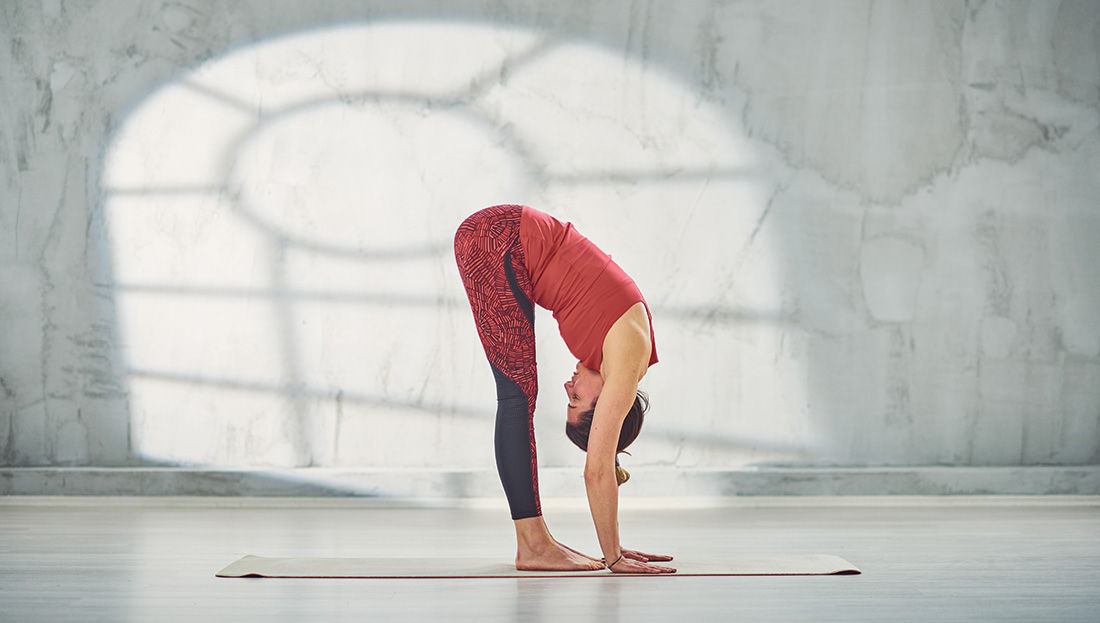
Years ago, at the beginning of my journey of trying to figure out the cause of my joint pain, an orthopedist asked me if I could touch my thumb to my forearm. And could I, while standing, bend over and touch the floor? Could I do splits on the floor—or could I when I was younger? Did I feel I was “double-jointed?”
The answer to all these questions was yes. She responded that there was a good chance I had hypermobile joints.
And you probably have students and clients with hypermobility, as well.
You know that client you’re always reminding to not hyperextend their knees during deadlifts? Or that student in class who hyperextends their elbows in upward-facing dog? There’s a good chance they have hypermobile joints, too.
Let’s take a deeper dive into what hypermobility is and how you can help clients and students who may have hypermobile joints.
What Is Hypermobility?
Despite it being a well-known condition, there is disagreement on the exact definition of hypermobility. The most common definition is simply a joint that exceeds its normal range of motion.
Due to a lack of a concrete definition, there is also a wide range of reported prevalence of the condition. For example, a 2017 review in The American Journal of Medicine states that joint hypermobility is present in about 3% of the general population. The study authors note, however, that joint hypermobility is most likely underreported, and the number is probably much higher. This may explain why a 2023 review in the journal Rheumatology International found the prevalence to be about 30% of the general population.
It’s important to note that hypermobility occurs within a spectrum—at one end is mild hypermobility and at the other is more pronounced hypermobility that may accompany other symptoms or be caused by an underlying condition.
Researchers are also unclear on the causes of hypermobility. Many are genetic, especially with specific syndromes, like Ehlers-Danlos syndrome and Marfan syndrome—both conditions that involve other systems of the body, and may actually be life-threatening.
“The number-one cause of hypermobility is genetics, so it cannot be prevented,” states Stephen Alberini, MPT, owner of Peak Performance Physical Therapy in Littleton, N.H.
My physician compared the joints to gears or cogs in a machine. If a gear—or the connective tissue that holds the joint together—is lax, it allows for excessive motion in the joint, and rubs against the structures next to it, wearing it down faster. This, in turn, can cause arthritis and other issues.
“Often, this excess motion is due to abnormalities in the soft tissue structures that encapsulate or surround the joints—specifically, the collagen that comprises these structures,” explains Wayne Lamarre, MEd, LAT, ATC, clinical professor and director of the Master of Science in Athletic Training Program at the University of New England (UNE).
While it is possible to be hypermobile in just one or two joints, it’s more common to have generalized joint hypermobility throughout the body. According to a 2021 study in Rheumatology International, generalized joint hypermobility (GJH) is defined as “the simultaneous presence of joint hypermobility at the four limbs and axial skeleton, with involvement of both the major and minor joints.”
“Generalized joint hypermobility usually impacts all the joints,” explains Lamarre, “but its effects are felt differently, depending on the person’s level of general fitness, overall strength and activity profile. Individual joints can also be hypermobile following certain types of injuries, too. The glenohumeral joint of the shoulder, for example, is often rendered hypermobile after a partial or complete dislocation.”
How to Assess for Hypermobility
There are several assessments available that can help determine if someone has joint hypermobility.
“I recommend utilizing the Beighton Score to assess for hypermobility due to its simplicity and ability for individuals to self-assess, especially since some joints may be painful near the end ranges of motion,” says Alberini.
“Both the Beighton Score and the Carter and Wilkinson Criteria score are the most commonly used instruments to evaluate hypermobility,” says Lamarre. “In each case, the examiner assesses the hypermobility of a prescribed set of joints—like the thumbs, the fingers and the knees—and calculates the overall score. Excessive movement at the knee (hyperextension or genu recurvatum) or the elbow (cubital recurvatum) are often some of the first indicators of GJH.”
Lamarre adds that people who could do splits or considered themselves “double jointed” as kids often have higher Beighton Scores.
What Precautions Should Be Taken with Someone with GJH?
Many people with GJH tend to lack proprioceptive acuity. In other words, a client who stands with their knees hyperextended probably doesn’t even realize they’re doing it. It feels normal to them. But this lack of proprioception also places them at higher risk for injury.
“The feedback to the nervous system is dysregulated in clients with hypermobility,” explains Lynne Olson, MFA, NASM-CPT, CES, owner of Rolling Brook Yoga, LLC, in Catonsville, MD, “which means that proprioception is more of a challenge.”
GJH also tends to lend itself to reduced muscle mass and strength. Researchers feel this may be due to the laxity in the tendons, resulting in the inability to transmit power to the muscles. And sometimes kids with GJH become more sedentary—and stay that course into adulthood—especially if they’re prone to injury or if physical activity has become painful.
When working with clients and students who have joint hypermobility, there are some precautions and guidelines that will allow you to help them in meaningful, productive ways to get the results they’re after.
Olson recommends slow, controlled movement with your feedback to give your clients time to learn how their body is positioned and how to properly control movement. “Down-regulating the nervous system through restorative yoga, meditation and breath work can also be helpful.”
Heath Pierce, MEd, ACSM EP-C, Assistant Dean of the Westbrook College of Health Professions at the University of New England and clinical professor and director of UNE’s Applied Exercise Science Program, agrees. “For those individuals that do seem to have the ability to hyperextend their elbows and knees, we recommend that they pay particular attention to avoiding that movement during exercises like squats, lunges, push-ups or planks. Constantly moving beyond a joint’s normal range of motion places additional stress on the non-contractile structures—like ligaments and joint capsules—and can lead to an increase in joint hypermobility over time.”
Ironically, says Olson, many people with GJH report feeling tight in their joints. “Since the ligaments around a joint don’t provide the stability that they should, the muscles have to work to support the joint instead,” says Olson. “In other words, the nervous system registers too much instability in the joint and tries to protect it by semi-engaging the muscles around it.”
Olson suggests limiting stretches to more moderate ranges. “It’s important for individuals who have hypermobile joints to achieve a baseline of compensation-free movements before they start to add external load to their movements,” explains Olson. “Fitness professionals should focus on building body awareness by training basic movement patterns until their clients achieve compensation-free movement.”
Pierce suggests that you remind clients “to pay close attention to how they feel and any signs and symptoms that develop during activity. They should exercise within a range of motion that is comfortable and well-tolerated. If they feel joint sensitivity, pain and/or discomfort while exercising, their body could be letting them know that they are attempting to perform beyond their ability.” If this happens, explains Pierce, have your client stop the exercise and provide a modification, such as changing the range of motion, joint position and/or speed of movement. “They should control the exercise movement versus the movement controlling them,” he says.
What Exercises are Recommended for GJH?
Building on achieving compensation-free movement, Olson recommends isometrics, which “can be helpful for reinforcing a neuromuscular connection to the nervous system.”
“During an isometric exercise, there is no movement of a joint,” adds Pierce. “The surrounding soft tissue—muscles, tendons and ligaments—adapt by increasing strength and endurance, which in turn, increase the stability and structural integrity of the joint.”
Isometric exercises such as wall sits, hip/pelvic bridging and whole-body planks, explains Pierce, can help “balance the excess in mobility with stability.”
Of course, it’s important to modify these exercises according to each client’s strength, endurance and pain levels. For example, wall sits can be modified by allowing for greater than 90 degrees at the hips and knees; and progressively over time, your client can work toward achieving 90 degrees. Similarly, have clients perform planks on their knees at first and progressively work toward planks with full extension, first with feet widely separated and then with feet together.
“Take precautions to not progress load too quickly and never progress load and repetitions on the same day,” cautions Alberini. “Be sure to perform exercises slowly and avoid painful ranges of motion.”
One often-forgotten area is the pelvic floor. “Pelvic floor instability tends to be prevalent in people with hypermobility,” adds Alberini, “so exercises such as hip adduction squeezes and band hip abduction to help stabilize the pelvis are recommended as well.”
Finally, be sure to offer plenty of feedback during client sessions and classes so that they can begin increasing their proprioception awareness and notice the positioning of their joints when they are exercising on their own. Also, ask for their feedback on how exercises are feeling to them, which will allow them to work on both proprioception and communication.
Remember that your goal as a health and exercise professional is to provide safe, efficient and effective exercise sessions for your clients. In the case of hypermobility, one of the primary goals is to balance excessive mobility with stability—which ultimately will also help make physical activity enjoyable for your clients—perhaps for the first time in their lives.





 by
by 


